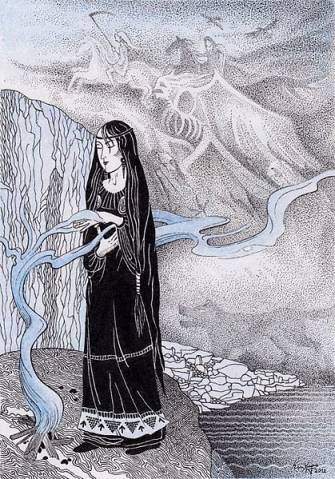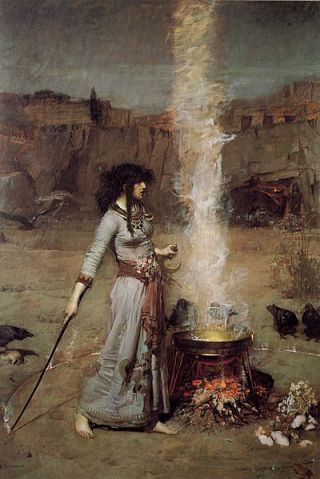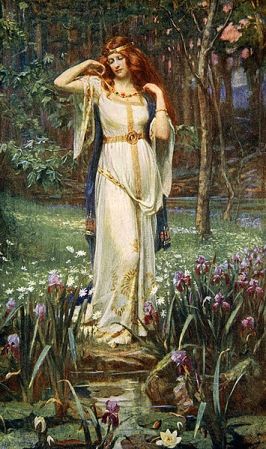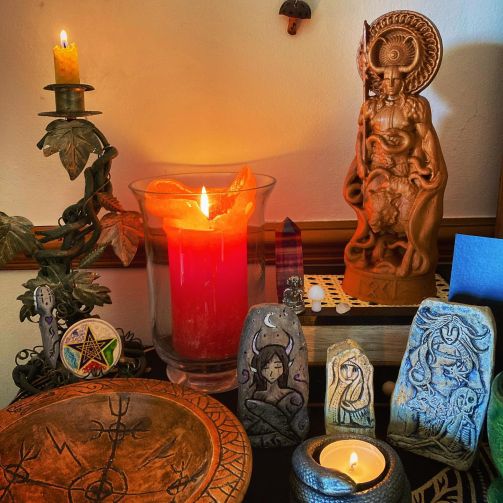The Viking Age, a period marked by exploration, trade, and conquest, gave birth to Seidr. This indigenous Norse practice might have been influenced by other cultures, such as the Saami and Finno-Ugric peoples. Over time, it evolved and integrated into the Norse belief system, reflecting their complex understanding of the universe and the supernatural.
Seidr likely started as a form of shamanism in the early stages of Norse culture. As the Viking Age progressed, it became more entwined with the Norse cosmology and the belief in a complex web of fate called “Wyrd” or “Urðr.” This integration shows the importance of magical arts in their society.
Practitioners of Seidr

Both men and women practiced Seidr, but female practitioners called völvas or seiðkonur were more common. These women played essential roles in Viking society, offering guidance and protection to their communities through their magical abilities. They mastered various techniques, such as divination, healing, and manipulating the threads of fate, which allowed them to wield significant influence over others’ lives.
People from all levels of society, including the highest echelons, sought the services of völvas and seiðkonur. Their role in the community went beyond magical practices, as they also served as counselors and mediators in disputes. This highlights their critical function in maintaining social harmony and cohesion.
However, male practitioners could face social stigma, as it was often considered unmanly or effeminate. This attitude could lead to a loss of honor or social standing. Despite this, some men used this magic, such as the Allfather himself, Odin, who was very learned and often practiced it.
The stigma surrounding male practitioners is rooted deeply in the Viking concept of honor and masculinity. Men engaging in Seidr risked being labeled “argr,” a term describing someone who had forsaken traditional masculine roles. This perception could have severe consequences for a man’s reputation, limiting his ability to form alliances or find a suitable marriage partner.
Seidr rituals and practices
Seidr rituals often required practitioners to enter trance states or altered states of consciousness, allowing them to access hidden realms and communicate with various beings. By using specific techniques, such as chanting, drumming, or consuming psychoactive substances, they could reach these altered states and gain insights into the past, present, and future.
Entering a trance state was crucial in Seidr practice, as it allowed the practitioner to bridge the gap between the mundane world and the supernatural realms. During these trance states, practitioners might receive visions, communicate with spirits, or even journey to other worlds within the Norse cosmology. These experiences provided them with the knowledge and power necessary to affect the course of events in the physical world.
Divination and communication with other realms were central aspects of Seidr. Practitioners communicated with gods, the dead, and other entities to gain knowledge or seek guidance. In addition, they could access and manipulate the Norns threads of fate, which governed the lives of all beings in Norse cosmology. This ability to influence fate made Seidr practitioners invaluable to their communities, as they could help shape the course of events to their advantage.

Healing and Protection
They also performed various forms of healing and protection magic, often using their knowledge of herbs, runes, and other magical techniques. These skills made them indispensable during times of illness or strife, as they could provide both physical and spiritual remedies for their communities.
Seidr practitioners employed various tools and symbols, like staffs, distaffs, and other items, to assist in their rituals. These tools held symbolic significance, acting as conduits for the practitioner’s power and helping them focus their intentions during rituals. The use of specific tools and symbols further highlights the importance of ritual and symbolism within the Norse magical arts.
The design and construction of these ritual items often incorporated deep meaning, reflecting the cosmological beliefs and principles of the Norse people. For instance, a Seidr practitioner might adorn their staff with runes, symbols of the gods, or other iconography that held particular significance for the individual or their community. These intricately designed items not only served as functional tools but also as powerful symbols of the practitioner’s connection to the spiritual world.
Comparing Seidr with Galdr
Seidr and Galdr, both forms of magic in Norse tradition, differ in techniques, purposes, and associations. Seidr involves shamanistic practices like altered states of consciousness, fate manipulation, divination, and healing. It is often associated with female practitioners known as völvas or seiðkonur and is closely linked to the god Odin and goddess Freyja. In contrast, Galdr focuses more on using runes, incantations, and chants to achieve desired effects. It is commonly associated with male practitioners, although women could also practice Galdr.
Seidr centers on accessing and manipulating hidden realms and the threads of fate, while Galdr primarily concerns with harnessing the power of runes and their associated symbolism. Galdr involves reciting runic formulas or verses, often as poetic stanzas or songs, to invoke specific effects or outcomes. These effects might include protection, healing, personal power increase, or weather control. The use of runes and incantations in Galdr reflects the importance of language, sound, and symbolism in Norse magical practice. In comparison, Seidr emphasizes altered states of consciousness, trance, and communication with various beings.
Despite their differences, they share some common ground. Both practices were integral to the spiritual beliefs of the Vikings and played significant roles in their society. Additionally, they each relied on a deep understanding of Norse cosmology, mythology, and symbolism. Both Seidr and Galdr practitioners were respected, and possibly feared, for their knowledge and abilities.
However, they had to navigate the complex social dynamics surrounding the practice of magic in Viking society. Seidr and Galdr represent two distinct yet interconnected aspects of the magical arts in Norse tradition, contributing to a broader understanding of the Vikings’ relationship with the supernatural world.
Seidr in Norse mythology

The chief god of the Norse pantheon, Odin, had a close association with Seidr. He possibly learned the art from the goddess Freyja, who was considered the foremost practitioner of Seidr. Odin’s quest for knowledge and wisdom led him to explore various forms of magic. He used it in numerous myths to achieve his goals.
Odin’s mastery was one of the many attributes that set him apart from the other gods. It often played a crucial role in his various exploits. For example, in the myth of the Mead of Poetry, Odin uses his Seidr skills to obtain the mead. This mead grants the gift of poetry and wisdom to those who drink it. This story exemplifies Odin’s cunning and his willingness to use it to further his own ambitions.
Freyja
Freyja, the goddess of love, fertility, and war, was also the patroness of Seidr. As a master of the magical arts, she wielded immense power. She was often called upon by other gods for her skills. In Norse myths, Freyja used Seidr for various purposes, such as protecting her favored heroes or seeking knowledge about the future. Freyja’s connection to Seidr reinforced her status as a powerful and influential figure within the Norse pantheon.
Seidr played a significant role in various other myths as well. For example, in the Völuspá, a völva recounts the history of the cosmos and prophesies the eventual destruction and rebirth of the world. The völva’s ability to access hidden knowledge and divine the future demonstrates the importance of Seidr in Norse mythology.
Moreover, several sagas and stories include Seidr practitioners as central or peripheral characters, emphasizing the pervasive nature of magic in the Norse world. These practitioners might aid or hinder the protagonists, showcasing the multifaceted nature of Seidr and the moral complexities that surrounded its use.
Impact of Seidr on Viking Society
The practice of Seidr had both benefits and dangers in Viking society. It could be used for protective and beneficial purposes, such as healing, ensuring good harvests, or warding off evil spirits. However, it could also be employed for malicious intent, such as cursing enemies or causing misfortune. The double-edged nature of Seidr meant that its practitioners were both respected and feared. Using Seidr for harmful purposes could result in retribution or misfortune for the practitioners themselves.
Social attitudes towards Seidr were complex, as it intersected with issues of honor, reputation, and gender roles. Practitioners, particularly völvas and seiðkonur, were valued for their abilities. However, the practice of Seidr could also be seen as a challenge to traditional gender roles. This was especially true for male practitioners, who risked being perceived as unmanly and could lose their social standing as a result.
These shifting attitudes towards Seidr practitioners reveal the complex dynamics of power and reputation in Viking society. While the magical abilities of Seidr practitioners could bring them respect and influence, they also had to navigate the social consequences of their actions and the perceptions of others. This delicate balance highlights the intricate web of social norms and expectations that governed the lives of the Vikings.
Modern perspectives and influence of Seidr

In recent years, there has been a growing interest in ancient spiritual practices and beliefs, including Seidr, among modern neo-pagan and Asatru communities. As part of this revival, contemporary practitioners seek to rediscover, reinterpret, and adapt traditional techniques for the modern era. This approach helps gain a better understanding of how Seidr was practiced during the Viking Age. By embracing, and incorporating it into their spiritual practices, these individuals aim to forge a connection with the ancient Norse worldview and create a sense of continuity with the past.
Modern practitioners often emphasize the importance of personal growth, self-discovery, and connection with nature. These values resonate with many individuals seeking alternative spiritual paths. Moreover, the revival of Seidr serves as a means to preserve and promote the rich cultural heritage of the Norse people.
As interest in Seidr and Norse spirituality continues to grow, more resources and educational materials have become available. This includes books, workshops, and online forums dedicated to the study and practice of Seidr. Consequently, this allows for a more accessible and inclusive environment for those wishing to explore this ancient magical tradition.
It is essential, however, for modern practitioners to approach the study with respect and sensitivity. As with any cultural tradition, it is important to be mindful of cultural appropriation and misrepresentation. By engaging with the historical and cultural context of Seidr and acknowledging its origins, modern practitioners can contribute to the preservation and understanding of this ancient magical art.
FAQs
Seidr is an ancient form of Norse magic practiced during the Viking Age, involving divination, healing, and manipulating fate. It was closely associated with shamanistic practices and was an integral part of Norse spiritual beliefs.
Both men and women practiced Seidr, but it was most commonly associated with female practitioners called völvas or seiðkonur. Male practitioners faced social stigma, as it was often considered unmanly.
Seidr rituals often involve entering altered states of consciousness or trance states, using techniques like chanting, drumming, or consuming psychoactive substances. These rituals allowed practitioners to access hidden realms and communicate with various beings.
Yes, Seidr practitioners employed various techniques for healing and protection, using their knowledge of herbs, runes, and other magical methods. They could provide physical and spiritual remedies for their communities.
Seidr practitioners used tools such as staffs, distaffs, and other items with symbolic significance. These tools helped them focus their intentions and served as conduits for their magical power during rituals.
While Seidr could be used for beneficial purposes, it could also be employed for malicious intent, such as cursing enemies or causing misfortune. Using Seidr for harmful purposes could result in retribution or misfortune for the practitioner.
Seidr has experienced a resurgence of interest in modern times, particularly among practitioners of modern pagan and neo-shamanic traditions. These individuals often reinterpret ancient Seidr practices for a contemporary audience.
Parting Thoughts
In conclusion, the study of Seidr offers a fascinating glimpse into the world of the Vikings and their complex relationship with magic, power, and the supernatural. By exploring the history, practices, and mythology of Seidr, we can gain a deeper understanding of the values and beliefs that shaped Viking society and continue to inspire and captivate people today.
Featured Image Credit: samijzitter via Instagram
